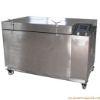- Cargo & Storage Equipment[9]
- Industrial Freezer[10]
- Other Metal Processing Machinery[10]
- Cold Room[1]
- Metal Processing Machinery Parts[1]
- Other Refrigeration & Heat Exchange Equipment[10]
- Emergency & Clinics Apparatus[1]
- Refrigerator Parts[1]
- Other Food Processing Machinery[10]
- Industrial Chiller[3]
- Machinery Design Services[3]
- Machinery Processing Services[4]
- Rack Gears[3]
- Mould Design & Processing Services[1]
- Other Metals & Metal Products[1]
- Other Material Handling Equipment[1]
- Machinery Parts Processing Services[1]
- Spur Gears[1]
- Contact Person : Ms. Zhang Alisa
- Company Name : Cryogenic (Beijing) Science & Technology Co., Ltd.
- Tel : 86-010-89787608
- Fax : 86-010-89787608
- Address : Beijing,changping,Rm. 6, 6/F, Tower A, No. 5, Chaoqian Road
- Country/Region : China
Cold trentment
I. What is Cryogenic treatment?Cryogenic treatment is a process after heat treatment. During cryogenic treatment process, the metal workpiece will be treated below -196°C. The process will make the soft austenite retained in the workpiece become hard martensite and decrease loose and roughness of the workpiece’s surfaces. After the process, not only the hardness, abrasive resistance and toughness of the workpiece’s surface increase, but also that of the whole workpiece increase and other performances of the workpiece improve. After process of cryogenic treatment, the cutter and molds, which have been even refurbished several times, are still harder, more abrasive resistant and the service life of the cutter and molds doubles. In comparison, if the workpiece without the process of cryogenic treatment is refurbished, the service life of it will shorten observably. The process of cryogenic treatment not only applies to the manufacture of cutter, but also applies to that of molds. And the process can prolong the service life of the molds. 2,Mechanism of the cryogenic treatment1. Eliminating the retained austenite:Generally speaking, after the metal workpiece is tempered and quenched, the retained austenite accounts for 8-20% of the volume of the metal workpiece. As time goes on, the retained austenite will become to martenite. During the procedure of martensitic transformation, the volume of the metal workpiece will be expanded. Consequently martensitic transformation will affect accuracy of the dimensions, increase the internal stress of crystals and badly affect the performance of the metal workpiece. The process of cryogenic treatment can make the retained austenite fall below 2% and eliminate the performance of the retained austenite. If retained austenite in the metal workpiece are more, the strength of the metal workpiece will decrease. Under the effect of cyclic stress, the retained austenite drop off easily. Consequently, the particles of the carbide near the retained austenite suspend and then drop off to generate flaking pits. As thus, the surfaces of the metal workpiece become more roughness.2. Filling up the internal gaps, the wear-resistant surface increasingCryogenic treatment makes the martenite fill up the internal gaps of the metal workpiece, the surfaces of the metal workpiece be more dense, the wear-resistant area increase, the crystal lattice be smaller, the precipitation of alloying constituent be even, the depth of quenched case increase. Cryogenic treatment can also increase the times of refurbishment and service life of the metal workpiece.3. Dissolving out particles of carbide:After the workpiece is treated by cryogenic treatment, not only the detained austenite in it decrease, but also the particles of carbide in it can dissolve out and refine Li Jing of martenite in it.Because the shrinkage of the martenite impels the crystal lattice to decrease and forces carbon atoms to dissolve out during the process of cryogenic treatment, the hardness and roughness of the metal workpiece treated by cryogenic will increase. Because the diffusion of
carbon atoms are difficult under low temperature, the demission of the carbide can reach nanoscale and the carbide attach to the band of Li Jing of martenite. Above is another reason why the hardness and roughness of the metal workpiece treated by cryogenic can increase. The evident difference between the wear pattern of metal treated by cryogenic and that of metal untreated by cryogenic shows the difference between the wear mechanism of them. Cryogenic treatment can make most detained austenite become martenite, dissolve out particles of carbide with high degree of dispersion in the martenite and refine ground tissue. Above changes can not be explained by theories of traditional metallography and phase inversion. These changes are also not performed in the form of atomic diffusion because atoms loses their ability of diffusions under the temperature of -160°C --- -180°C. Perhaps we only can explain these changes by the theory of energy capacity of physics. The mechanism is not totally clearly so there is a need for people to further research in this field. 4.Decreasing detained stresses5.Making the metal matrix more stable6.Increasing the hardness and roughness of the metals7.The hardness of the metal increases about HRC1-2 8Red hardness increases evidently.
Cold trentment










